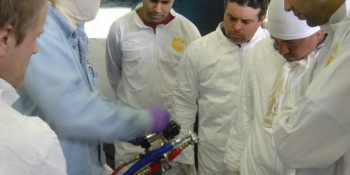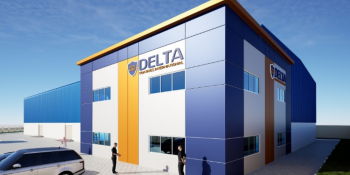Q&A Forums
6.7 lb foam Post New Topic | Post Reply
| Author | Comments |
|---|---|
|
Posted: Oct 17, 2011 11:17 PM
|
6.7 lb foam
I am just getting started in this business and have a question. I am about to give an estimate on some poultry houses and i need to know how many bd ft the 6. 7 lb foam will cover. To the best of my understanding it is only to be sprayed 1 inch thick.
|
|
mason
Posted: Oct 18, 2011 12:30 PM
|
I think you have the density mixed up. To my knowledge no one currently makes a 6 lb density sprayfoam. It would have the strength and insulative value of wood. I have sprayed a 6 lb foam 35 years ago that was manufactured by a local supplier in Houston. Yield is horrible. We thought it might be used to reinforce structural components of houses and buildings, but it was far too brittle. |
|
Lynn Mether
Posted: Oct 19, 2011 11:26 AM
|
Does this happen to be a ag-seal or ag-tite product? |
|
Posted: Oct 20, 2011 02:24 PM
|
Yes it is Ag Seal or AgriThane |
|
mason
Posted: Oct 25, 2011 05:22 PM
|
I went to the websites of Ag Seal and Ag Tite. I did not find data sheets on the material. But you can do the calculations. 6.7 lb density foam would theoretically cover 6.7 lbs per cubic foot of foam. One cubic foot equals 12 board feet. So the free rise foam would require 6.7 lbs to cover 12 square feet at one inch thick. It will spray in place at a higher density, so add at least 20% then add another 15-50% depending on how uniform you can spray it. 10-15%% if you can spray within 1/4 inch and 40 - 50% if you can only spray within a half inch tolerance. So if you can get the best uniformity, figure about 8.5 to 9 lbs per cubic foot or .7 to .8 lbs per foot. Anyone who has sprayed this, please chime in with your experience. |
|
Roger Morrison
Posted: Oct 26, 2011 06:20 AM
|
I think you may be confusing density with R-value. The "Agrithane" that I am familiar with has a density of 2 lb/cuft with an R-value around 6.7. |
|
Posted: Oct 26, 2011 08:07 AM
|
Yes agrithane is a 2 lb foam but AgSeal is either a 3.4 or 6.7 lb foam. Im sure of that. |
|
jeff henderson
Posted: Oct 26, 2011 01:49 PM
|
"6.7lb extreme Peck Proof foam seals wall plate and footer. Rigid closed cell foam that provides air barrier and moisture barrier. Very tough almost like a truck bed liner." I assume (!) 1,050 pounds....so 156 cubic feet....1,872 board feet |
|
SprayFoamSupply.com
Posted: Oct 27, 2011 06:09 AM
|
Theoretical yield and actual yield can vary quite a bit. I would estimate the yield of a 6.7lb foam would be about 1,200-1,400 board feet per 1,000lb set. I traveld to Maryland a few years ago to visit a chicken farm. You spray a 2lb foam on all of the walls and then the bottom two feet are top coated with a higher density foam to prevent the chickens from pecking into the foam. The foam is also black in color. I was very impressed at all the science that goes into raising chickens! George |
|
Posted: Dec 04, 2011 10:54 PM
|
Mason, High density polyurethanes have been used for almost 7+ years now and are very successful in their ability to seal to work in many markets. View www.sealanttech.com to see more. Regards, William Collins |
|
mason
Posted: Dec 05, 2011 12:22 PM
|
William, I did find out about the higher density sprayfoams during my research on this topic. I am still wondering about the relative brittleness of the products. In my previous experience with spraying 6 lb density foams in the 80s, the foams had great tensile strength and impact resistance, but cracked fairly easily under thermal shock conditions. No problems with the newer 6 lb formulas? Just wondering. |
|
Posted: Dec 05, 2011 02:35 PM
|
Hey Mason, When we talk about high density polyurethanes, I categorize them as being between 3lb - 10lb densities. So for this discussion, don't think in terms of just one density ( like 6lb ). Yes, the flexibility can be built into the chemistry and even at a flash coat ( 1/8" ) you can get tremendous flexibility, but still have the strength that comes with a high density polyurethane. In most cases, you wouldn't spray any of these at more 1/2" in thickness, so it is a true sealant and not an insulator. The other benefit that can be built into the chemistry is a hard shell so imagine the finished product looking more like polyurea and not a foam. The key to the durability of any of these sealants is to have a smooth surface so when they are sprayed, it most important to get an almost plastic like finish. In many applications, especially in agriculture, it will create a very long life, even if exposed to severe elements. |
|
mason
Posted: Dec 06, 2011 09:53 AM
|
I actually have a lot of experience with high density polyurethane foams. We used to make high density saddles for tank car insulation projects with a pour-in-place a 15- 20 lb density foam when I worked for my Dad in the 70s and while working for E R Carpenter in the 80s, I was the technical rep for OEM accounts that used 6-12 lb density foam in a large variety of applications such as decorative plaques, hot tub enclosures (make it look like redwood) and more. I can see that in the thinner applications you could have greater flexibility. My personal experience with 6 lb sprayfoam was in thicker applications (roofing to minimize hail damage, interior applications to provide structural strength to framing in construction). Our foams did not provide the flexibility required for those applications. Thanks for your clarification. |
|
AgSeal
Posted: Oct 30, 2016 01:19 PM
|
Mason We here at AgSeal started out using 6lb foam usually applied at target thickness of 3/8". Yes yield sucks but it's just a protective layer on the lower 24" of a poultry house. Usually applied over an 1" layer of our basic 2.4lb foam or our specialized 3.4ICA(dbk) foam. On some other agriculture applications it can be greater and thicker. Real pain to get it applied thicker than 1/2" per pass and not have exotherm issues. We actually now have moved to either a 10.4lb option or Urea. These two have more durability and eliminate most possible application caused failures. Feel free to give us a call and we would be more than happy to help you out with product, training, whatever we can do to help you succeeed. As for the poultry business well far as I know, no one other than us supplies on avg 1 million pounds per year into this industry. We try to stay ahead of the curve material wise and price wise. That and are willing to bust our asses so us and our dealers succeed! Wish you the best of luck! Call us if we can help! |





























